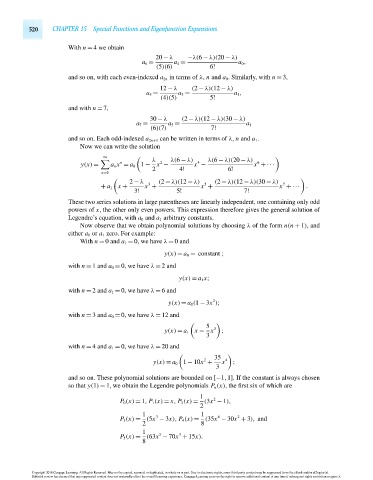Page 540 - Advanced_Engineering_Mathematics o'neil
P. 540
520 CHAPTER 15 Special Functions and Eigenfunction Expansions
With n = 4 we obtain
20 − λ −λ(6 − λ)(20 − λ)
a 6 = a 4 = a 0 ,
(5)(6) 6!
and so on, with each even-indexed a 2n in terms of λ, n and a 0 . Similarly, with n = 3,
12 − λ (2 − λ)(12 − λ)
a 5 = a 3 = a 1 ,
(4)(5) 5!
and with n = 7,
30 − λ (2 − λ)(12 − λ)(30 − λ)
a 7 = a 5 = a 1
(6)(7) 7!
and so on. Each odd-indexed a 2n+1 can be written in terms of λ, n and a 1 .
Now we can write the solution
∞
λ λ(6 − λ) λ(6 − λ)(20 − λ)
n 2 4 6
y(x) = a n x = a 0 1 − x − x − x + ···
2 4! 6!
n=0
2 − λ 3 (2 − λ)(12 − λ) 5 (2 − λ)(12 − λ)(30 − λ) 7
+ a 1 x + x + x + x + ··· .
3! 5! 7!
These two series solutions in large parentheses are linearly independent, one containing only odd
powers of x, the other only even powers. This expression therefore gives the general solution of
Legendre’s equation, with a 0 and a 1 arbitrary constants.
Now observe that we obtain polynomial solutions by choosing λ of the form n(n + 1), and
either a 0 or a 1 zero. For example:
With n = 0 and a 1 = 0, we have λ = 0 and
y(x) = a 0 = constant ;
with n = 1 and a 0 = 0, we have λ = 2 and
y(x) = a 1 x;
with n = 2 and a 1 = 0, we have λ = 6 and
2
y(x) = a 0 (1 − 3x );
with n = 3 and a 0 = 0, we have λ = 12 and
5
y(x) = a 1 x − x 3 ;
3
with n = 4 and a 1 = 0, we have λ = 20 and
35
2 4
y(x) = a 0 1 − 10x + x ;
3
and so on. These polynomial solutions are bounded on [−1,1]. If the constant is always chosen
so that y(1) = 1, we obtain the Legendre polynomials P n (x), the first six of which are
1
2
P 0 (x) = 1, P 1 (x) = x, P 2 (x) = (3x − 1),
2
1 1
4
3
2
P 3 (x) = (5x − 3x), P 4 (x) = (35x − 30x + 3), and
2 8
1
5
3
P 5 (x) = (63x − 70x + 15x).
8
Copyright 2010 Cengage Learning. All Rights Reserved. May not be copied, scanned, or duplicated, in whole or in part. Due to electronic rights, some third party content may be suppressed from the eBook and/or eChapter(s).
Editorial review has deemed that any suppressed content does not materially affect the overall learning experience. Cengage Learning reserves the right to remove additional content at any time if subsequent rights restrictions require it.
October 14, 2010 15:20 THM/NEIL Page-520 27410_15_ch15_p505-562

